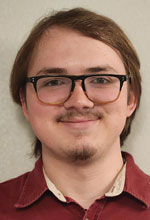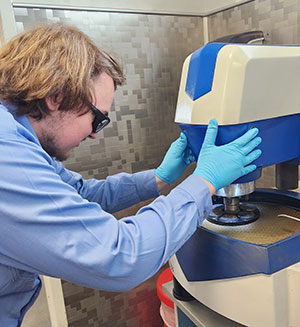2024 Steel Intern Scholarships
 Isaac R. Rhoden
Isaac R. Rhoden
It’s a common idea that the steel industry is one dominated by old views and even older methods of thinking. There are murmurs in the material science spheres — from the lowest to the highest points — that the steel industry is something of a titan. By no means was it getting worse, but it also wasn’t making any strides forward compared to the newer, flashier innovations that have been common as of late. When I first told people I was interning with SSAB Research and Development, the most common question I got was along the lines of “What’s left to research with steel?”. Now, with the experience I’ve gained as part of this team, I can confidently say the answer to the question of what’s left to research is “Practically everything”.
Over this summer, I had the incredible opportunity of working with the Research and Development team of SSAB Research & Development located in Montpelier, Iowa, USA, as part of the AIST Steel Intern Scholarship. I spent 13 weeks immersed in the culture and saw first-hand the incredible levels of advancement that SSAB prides itself on, and for good reason. Not only has my understanding of the steel industry grown, but my knowledge of how research and development functions and impacts the industry is now much more fleshed-out.
During this internship, I had two primary projects: one more hands-on project work, and the other being about the process of steel production. The hands-on project focused on the impact heat treatment has on the toughness of a specific grade of steel armor plate, and the process optimization project focused on the electric arc furnaces used by SSAB to melt down scrap, and how stability can impact them. By having projects that focused on different portions of the R&D umbrella, I got a well-rounded experience that allowed me a glimpse into not only what a corporate R&D team is like, but also into what’s important in the steel scene.
 For the armor plating project, I was involved in practically every part of the process — from cutting the steel plates down to size, heat treating and quenching the samples, and doing metallographic analysis to determine some of the microstructural properties of the steel. Additionally, I learned how to do prior austenite grain etching — a skill I was very excited about. I had to learn not only about how to complete all the tasks required of me for this project, but also what all the data those tasks gave me meant. As part of this, I had to do grain size analysis and correlate it with other physical properties of the steel to get a better idea of how they impacted it.
For the armor plating project, I was involved in practically every part of the process — from cutting the steel plates down to size, heat treating and quenching the samples, and doing metallographic analysis to determine some of the microstructural properties of the steel. Additionally, I learned how to do prior austenite grain etching — a skill I was very excited about. I had to learn not only about how to complete all the tasks required of me for this project, but also what all the data those tasks gave me meant. As part of this, I had to do grain size analysis and correlate it with other physical properties of the steel to get a better idea of how they impacted it.
As an almost direct opposition to the hands-on type of work done for the product development project, the other project regarding arc stability in electric arc furnaces that I focused on dealt with data analysis and interpretation on a scale I have never completed before. Every single point of data seen from an electric arc furnace is connected to practically everything else — all parameters directly impact every single other one. I learned to use ibaAnalyzer software to gather a huge amount of disparate data and make it useful. This project was rewarding in a different way than the hands-on project, in large part because this project relied on me to make the most of the methodology. I was given direction from the R&D staff of where to look, but ultimately all the data gathering, analysis and conclusions were mine to work towards. This project was extremely rewarding, as there is just so much to learn about this topic, and it felt like my work genuinely helped contribute to the information about it.
At the end of my time there, I had the opportunity to give a presentation to the members of R&D where I was able to give a formal presentation to a knowledgeable team. Working there deepened my desire to pursue a higher education and strive for roles like those I see around me in research and development. This internship has shown me that even though there are incredible amounts of research that have been completed long before I was even born, there is still so much we don’t know — so much room for improvement, just so long as we can get there and find out. I want to extend my thanks to not only the AIST Foundation for this opportunity and the scholarship, but also to everyone that I worked with at SSAB for making this an incredibly valuable experience.
